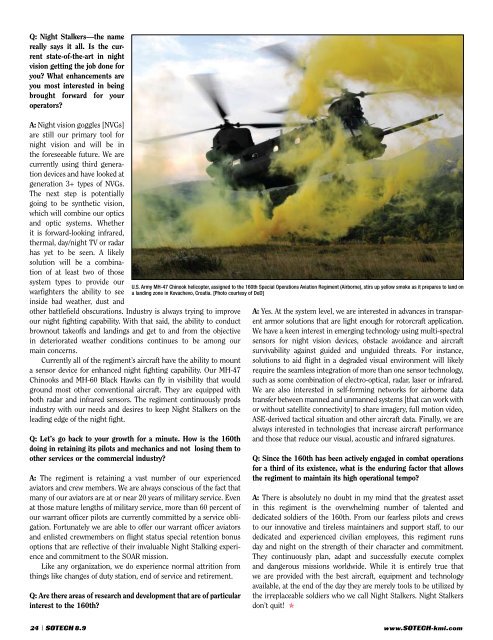Air Warrior Col. John W. Thompson - KMI Media Group
Air Warrior Col. John W. Thompson - KMI Media Group
Air Warrior Col. John W. Thompson - KMI Media Group
Create successful ePaper yourself
Turn your PDF publications into a flip-book with our unique Google optimized e-Paper software.
Q: Night Stalkers—the name<br />
really says it all. Is the current<br />
state-of-the-art in night<br />
vision getting the job done for<br />
you? What enhancements are<br />
you most interested in being<br />
brought forward for your<br />
operators?<br />
A: Night vision goggles [NVGs]<br />
are still our primary tool for<br />
night vision and will be in<br />
the foreseeable future. We are<br />
currently using third generation<br />
devices and have looked at<br />
generation 3+ types of NVGs.<br />
The next step is potentially<br />
going to be synthetic vision,<br />
which will combine our optics<br />
and optic systems. Whether<br />
it is forward-looking infrared,<br />
thermal, day/night TV or radar<br />
has yet to be seen. A likely<br />
solution will be a combination<br />
of at least two of those<br />
system types to provide our<br />
warfighters the ability to see<br />
inside bad weather, dust and<br />
other battlefield obscurations. Industry is always trying to improve<br />
our night fighting capability. With that said, the ability to conduct<br />
brownout takeoffs and landings and get to and from the objective<br />
in deteriorated weather conditions continues to be among our<br />
main concerns.<br />
Currently all of the regiment’s aircraft have the ability to mount<br />
a sensor device for enhanced night fighting capability. Our MH-47<br />
Chinooks and MH-60 Black Hawks can fly in visibility that would<br />
ground most other conventional aircraft. They are equipped with<br />
both radar and infrared sensors. The regiment continuously prods<br />
industry with our needs and desires to keep Night Stalkers on the<br />
leading edge of the night fight.<br />
Q: Let’s go back to your growth for a minute. How is the 160th<br />
doing in retaining its pilots and mechanics and not losing them to<br />
other services or the commercial industry?<br />
A: The regiment is retaining a vast number of our experienced<br />
aviators and crew members. We are always conscious of the fact that<br />
many of our aviators are at or near 20 years of military service. Even<br />
at those mature lengths of military service, more than 60 percent of<br />
our warrant officer pilots are currently committed by a service obligation.<br />
Fortunately we are able to offer our warrant officer aviators<br />
and enlisted crewmembers on flight status special retention bonus<br />
options that are reflective of their invaluable Night Stalking experience<br />
and commitment to the SOAR mission.<br />
Like any organization, we do experience normal attrition from<br />
things like changes of duty station, end of service and retirement.<br />
Q: Are there areas of research and development that are of particular<br />
interest to the 160th?<br />
24 | SOTECH 8.9<br />
U.S. Army MH-47 Chinook helicopter, assigned to the 160th Special Operations Aviation Regiment (<strong>Air</strong>borne), stirs up yellow smoke as it prepares to land on<br />
a landing zone in Kovachevo, Croatia. [Photo courtesy of DoD]<br />
A: Yes. At the system level, we are interested in advances in transparent<br />
armor solutions that are light enough for rotorcraft application.<br />
We have a keen interest in emerging technology using multi-spectral<br />
sensors for night vision devices, obstacle avoidance and aircraft<br />
survivability against guided and unguided threats. For instance,<br />
solutions to aid flight in a degraded visual environment will likely<br />
require the seamless integration of more than one sensor technology,<br />
such as some combination of electro-optical, radar, laser or infrared.<br />
We are also interested in self-forming networks for airborne data<br />
transfer between manned and unmanned systems [that can work with<br />
or without satellite connectivity] to share imagery, full motion video,<br />
ASE-derived tactical situation and other aircraft data. Finally, we are<br />
always interested in technologies that increase aircraft performance<br />
and those that reduce our visual, acoustic and infrared signatures.<br />
Q: Since the 160th has been actively engaged in combat operations<br />
for a third of its existence, what is the enduring factor that allows<br />
the regiment to maintain its high operational tempo?<br />
A: There is absolutely no doubt in my mind that the greatest asset<br />
in this regiment is the overwhelming number of talented and<br />
dedicated soldiers of the 160th. From our fearless pilots and crews<br />
to our innovative and tireless maintainers and support staff, to our<br />
dedicated and experienced civilian employees, this regiment runs<br />
day and night on the strength of their character and commitment.<br />
They continuously plan, adapt and successfully execute complex<br />
and dangerous missions worldwide. While it is entirely true that<br />
we are provided with the best aircraft, equipment and technology<br />
available, at the end of the day they are merely tools to be utilized by<br />
the irreplaceable soldiers who we call Night Stalkers. Night Stalkers<br />
don’t quit! O<br />
www.SOTECH-kmi.com
















